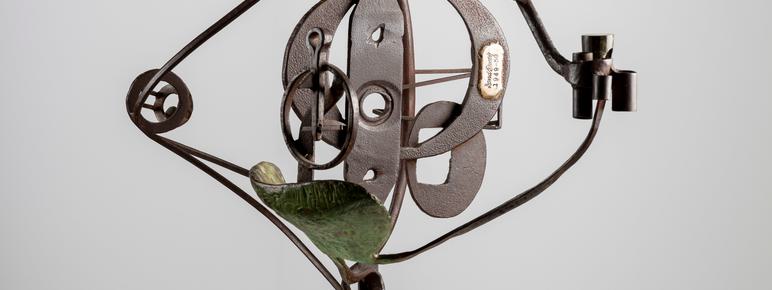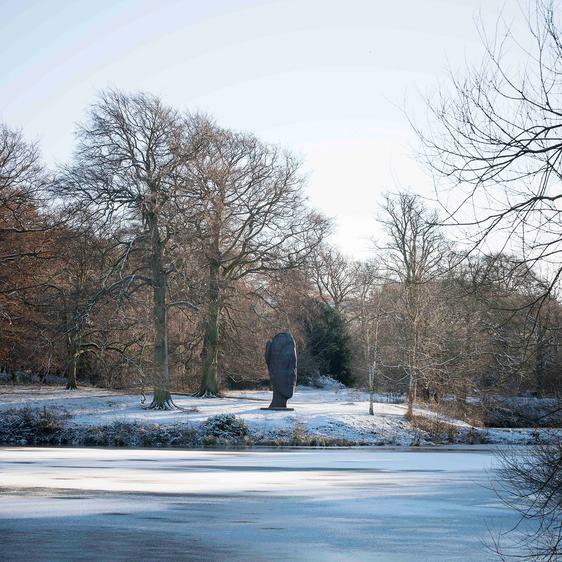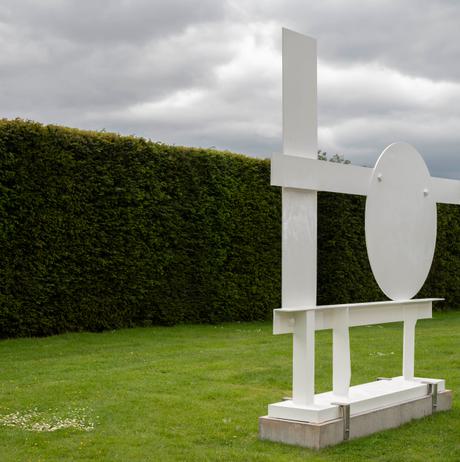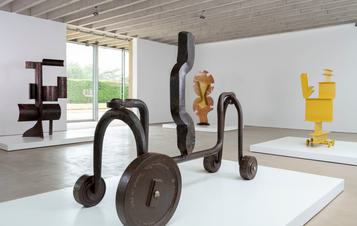
David Smith: Sculpture 1932 - 1965
– Underground Gallery, NAEA GalleryAbout David Smith: Sculpture 1932 - 1965
Part of Yorkshire Sculpture International
David Smith, the Michelangelo of welding...The painters of abstract expressionism didn't reinvent the wheel; Smith did.
- Waldemar Januszczak, The Sunday Times Culture
YSP presented a major exhibition of over 40 works by the pioneering and highly influential American artist David Smith (1906-1965).
Widely hailed as one of the 20th century’s outstanding sculptors, this was the first solo exhibition of Smith’s work in the UK since Tate Modern’s 2006 project and the largest ever outside the capital. This landmark exhibition charted the development of Smith’s unique visual language over four decades, crucially bringing together a number of his sculptures in the open-air rarely seen in this way outside the USA. Within the Underground Gallery, over 30 sculptures traced an unfolding narrative of material, technique and form. Beginning with Smith’s earliest constructions from the 1930s that combined wood with elements including mussel and clam shells, wire and nails, the exhibition spanned work through to the artist’s mature, bold, large-scale painted and stainless steel sculptures of the 1960s.
David Smith: Sculpture 1932-1965 was YSP’s headline exhibition for 2019 and the principal contribution to the inaugural Yorkshire Sculpture International, produced in partnership with the Henry Moore Institute, The Hepworth Wakefield, and Leeds Art Gallery. Yorkshire Sculpture International comprised a number of exhibitions exploring artist Phyllida Barlow’s statement that “sculpture is the most anthropological of the arts”. With Yorkshire’s rich history as the birthplace and inspiration for sculptors including Barbara Hepworth and Henry Moore, YSP's collaboration considered the human impulse to connect with objects, investigating both the physical diversity and the political agency of sculpture in the 20th and 21st centuries.
Smith challenged sculptural conventions and was the first artist in the USA to work with welded metal, becoming known for his mastery of steel. Although hugely influential to the development of abstract sculpture internationally, few of his works are held in non-US public collections, so he is rarely shown in Europe. Displayed at YSP, an incisive selection of sculptures included major loans from museums and private collections, together with works from the artist’s estate, including objects from his home that had not previously been exhibited.
3 StarsSmith alone is reason enough to visit Yorkshire
- Alastair Smart, The Mail on Sunday
Given the unique indoor-outdoor nature of YSP, a starting point for the exhibition was the importance to Smith of having his work in the open air, which in 1950 Robert Motherwell expressed as, “…an ineffable desire to see his humanness related to exterior reality, to nature at least if not to man.” Smith’s life was inextricably associated with his rural home and studio at Bolton Landing in upstate New York, where from the mid-1950s onwards, he filled the surrounding fields with sculpture, enjoying seeing them against the landscape, with the play of changing light across their surfaces. These sculptures were his companions, his achievements, and inspiration for future sculptures and by the time of his death in 1965, dozens of sculptures occupied ‘the fields’. Primo Piano III (1962), one of only three similar works by Smith, also made a critical contribution to the open-air display.
Also in the landscape at YSP, three works from the important Voltri series, that the artist made in Italy during a particularly creative and prolific period working in an abandoned steel factory, displayed the diversity of his approach to found material and to scale. YSP's setting uniquely contextualised Smith’s fusion of industry and nature, in a region recognised both for its towering heritage in steel and renowned for its scenic beauty.
The impressive Cubi XIX (1964) made in stainless steel indicates Smith’s ability in working this stubborn material, which in his hands becomes fluid while retaining its inherent qualities of tensile strength and durability. For Smith, the burnished, reflective surface of the material made it the perfect foil to explore the interchange of sculpture and painting, and to express the evolving relationship between his work and the natural environment: “I made them and I polished them in such a way that on a dull day, they take on the dull blue, or the color of the sky in the late afternoon sun… They reflect the colors.”
Highlights inside the gallery included Smith’s earliest sculptures, made in or with materials sourced from the Virgin Islands, which he visited in 1931-32. A selection of mixed media and wire Constructions (1932-33) indicated Smith’s evolving understanding of assembled and counterbalanced forms.
Also from the 1930s and reflecting the significant developments in his work over this period were Smith’s pivotal first welded pieces comprising found industrial objects. In 1933 he saw images of welded metal sculptures made collaboratively by Spanish artists Pablo Picasso and Julio González, and he described this moment as his ‘technical liberation’, realising that the industrial processes with which he was familiar and the making of art could come together. Created soon afterwards, Saw Head (1933) and Chain Head (1933) were perhaps the first sculptures ever made in this way in the United States.
The final pieces: gravity-defying and completely abstract juxtapositions of cuboid steel forms that seem to hang weightless over YSP's lawns, still project a dazzling sense of immediacy and sheer newness.
- Mark Hudson, The Telegraph
Smith’s understanding of the social practice and role of art was also drawn out. A politically engaged and strident believer in the need for the United States to be outward-facing and connected to the wider world, as well as being relevant to all branches and levels of society, his anti-Fascist stance was vividly illustrated by examples from the Medals for Dishonor series. In a prescient statement he wrote: “The tradition of our art is international, as are American people, customs and science. There is no true American art and there is no true American mind. Our art tradition is that of the Western world, which originally had its tradition in the East. Art cannot be divorced from time, place, or science.”
Smith aligned himself to an anthropological thread, embracing a creative continuity from prehistoric artefacts and ethnographic art, to that which is displayed within Eastern and Western art historical cultures. Smith spoke of his ‘workstream’, with connotations of connecting to an ancient tradition of working material by hand, and this exhibition examines the immediacy of his sculpture; its obdurate yet tactile nature; its shared space with man, machine, and natural forms; and the social and human impulse through which Smith developed abstraction from the automotive factory and foundry. For the first time ever, a number of artefacts that Smith collected whilst in Europe in the 1930s and which fed his imagination and emerging practice, were shown in a didactic space.
Encapsulating the artist’s lyrical, linear work from the 1950s, the iconic Hudson River Landscape is a vital and dynamic sculpture that synthesises and translates a train journey regularly taken by Smith into a captivating, whorled three-dimensional form. Smith deftly captured the essence of movement and memory, melding abstraction with narrative. Within the light-filled central gallery, Smith’s striking larger scale sculptures from the 1960s revealed the importance of surface and colour alongside bold and concentrated form; an ever-burgeoning output from a life and practice cut short in its prime.
You might also like
- Profile

Helen Whitehouse OBE
- Art Outdoors

David Nash: Black Mound
Black Mound was made for the YSP landscape by David Nash in 2013. Once in place, he charred the oak forms through a carefully controlled burning process that relates to his interest in the four elements. - Art Outdoors

Jaume Plensa: Wilsis
Wilsis appears to be deep in thought or dreaming. Her eyes are closed and she is inward-looking and self-contained, remote from the present moment and the beauty of the surrounding scenery. Although monumental in size at over 7 metres high, this sculpture depicts a normal girl, rather than immortalising a traditionally extraordinary or powerful person. - Event
Collagraph Printing Workshop with artist Andrew Waddington
Join Cornish based artist Andrew Waddington for a collagraph printing workshop at YSP's Hayloft Studio, inspired by his Betwixt and Between – The Poetry of Landscape exhibition at YSP Centre.





